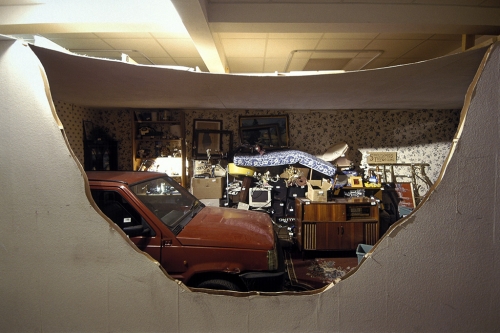King Tat
Peter Bonnell
King Tat is a newly commissioned installation by Shaun Doyle and Mally Mallinson at the John Hansard Gallery in Southampton. Even before arriving at the gallery, one question arises: who was King Tat? Is he a composite of peoples, of people who the local newspaper report as being found dead surrounded by a life-time of mouldering possessions and hoarded junk; or was he a real person? Whatever the case, in creating this celebration to the recently departed Doyle and Mallinson have transformed the Hansard galleries into a gigantic reliquary containing an installation that is equal parts solemn and humorous, and imbued with barely concealed social commentary.
The artists found inspiration for the tomb of King Tat in a recreation of Tutankhamen’s tomb exhibited at the British Empire Exhibition at Wembley in 1924. Doyle and Mallinson’s installation retains the stagey feel of the 1924 original, and begins with a corridor clad with woodchip wallpaper that ushers the viewer towards an antechamber. One wall of this chamber has been cleaved away – as if visited in the night by the ghost of Gordon Matta-Clark – revealing a dank and dusty room filled with junk and clutter that is more Bargain Hunt than Pharaoh’s tomb. In one corner is a small red car intended as a poor man’s chariot to the next world. How it managed to end up in what appears to be a cramped council flat is another matter. However, its inclusion adds to the pervading gloom; melancholy hangs in the air accentuating a sense of the recently departed; time appears to be suspended. A heap of junk is piled alongside the far wall – a digital alarm clock twinkles in the gloom, old clothes, bric-a-brac and piles of books jostle for place on old cabinets and sideboards. There is a definite sense of a personal history here allied to a sense of obsessive collecting. However, the air of sadness is exacerbated when one realises that the worthless objects laid out here, no doubt precious and personal to their former owner, serve only as a pitiful indictment of a life gone unnoticed.
At the far right-hand side of the antechamber is a bricked up doorway guarded either side by two gigantic kitsch ceramic dogs. Fortunately, we are allowed a look into this bricked up room as we move along the installation. As with the antechamber before it, the room is revealed by deft of cutaway and in its centre is the final resting place of Tat himself. His tomb, a chest freezer adorned with a Perspex lid (a sign of the times, no gold sarcophagus here) is eerily lit from within. On the walls are large-scale murals of racing cars and references to trashy movies. In places the walls are adorned with obscene graffiti, another sign of a modern malaise afflicting our public and private spaces. Doyle and Mallinson claim to find inspiration for these murals in graffiti found on council estates, wryly transformed here to reflect the murals and hieroglyphics of ancient Egypt.
To the side of the burial chamber is piled the various parts of walls that have been removed to allow us to look into the antechamber and burial room – discarded as if not for exhibition but in haste as if the tomb had been recently discovered. Adjacent to this in the Hansard project room is Waiting, a 1974 film by Elisabeth Kozmian-Ledward. This film, very much of its time, is narrated by a man describing the possessions in his tiny London flat. It too has an air of melancholy and perfectly complements the Tat installation. In fact one has to wonder if this person, who we glimpse from time to time, is King Tat himself, albeit in an earlier stage of his life, before his obsessive collecting and fall into obscurity had begun.
In aspiring to the stately tomb of Tutankhamen, Doyle and Mallinson have created a celebration of what is essentially an undercurrent of modern life: people who have been neglected by polite society, lost to the overstretched social services; people who slip through the cracks and often die in squalor. Maybe King Tat was a real person to be loved and cherished, not neglected. His final resting place, a grimly humorous place, is a poke in the ribs to modern society to not look the other way and acts as a reminder that we should honour ordinary people as well as the more regal amongst us.
Published in ‘an Reviews Unedited’, www.a-n.co.uk
Peter Bonnell
Exhibitions and Education Officer at ArtSway.
